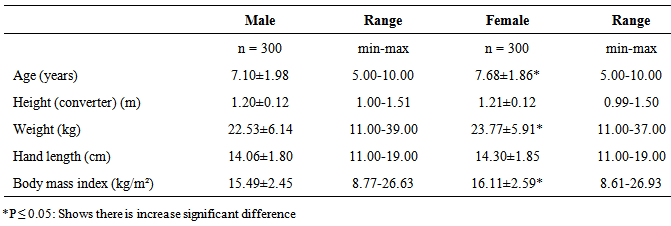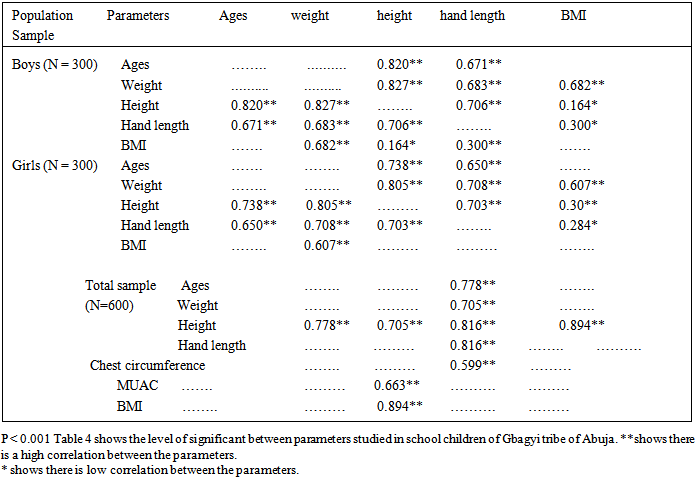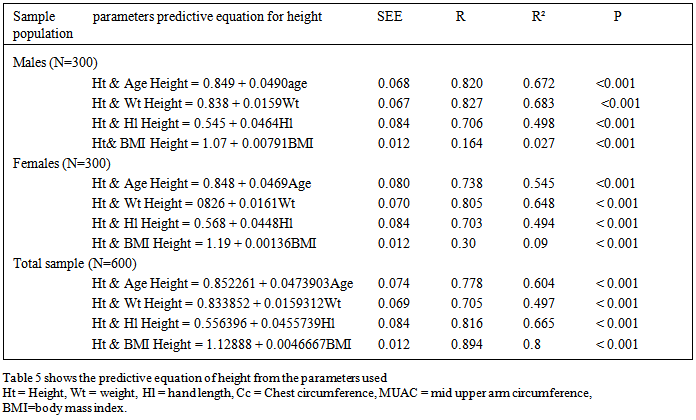-
Paper Information
- Paper Submission
-
Journal Information
- About This Journal
- Editorial Board
- Current Issue
- Archive
- Author Guidelines
- Contact Us
Advances in Life Sciences
p-ISSN: 2163-1387 e-ISSN: 2163-1395
2015; 5(1): 12-17
doi:10.5923/j.als.20150501.02
Hand Length as a Determinat of Height in School Children
A. O. Ibegbu, E. T. David, W. O. Hamman, U. E. Umana, S. A. Musa
Department of Human Anatomy, Faculty of Medicine Ahmadu Bello University Zaria, Kaduna State, Nigeria
Correspondence to: A. O. Ibegbu, Department of Human Anatomy, Faculty of Medicine Ahmadu Bello University Zaria, Kaduna State, Nigeria.
| Email: |  |
Copyright © 2015 Scientific & Academic Publishing. All Rights Reserved.
The anthropometric characteristics of 600 normal Nigeria School Children of ages between 5-10 years of Gbagyi tribe of Abuja, with no obvious deformities or previous history of trauma to the hand were selected for this study. Of these children, males (n=300) with mean age of 7.10 ± 1.98, and females (n=300) with mean age of 7.68 ± 1.86) were investigated. The anthropometric characteristics of their height, age, weight, hand length, and body mass indices were measured, analysed statistically for any significant difference, and correlation between the parameters studied. The results show some significant differences between the anthropometric parameters and a significant correlation (≤ 0.001) between the height and hand length, and other parameters in both males and females. The study derived a linear regression and a multiple linear regression equations for Gbagyi School children of Nigeria from which height, age, weight, hand length and body mass index could be predicted if one factor is known. The results from the present study show that there was a positive correlation between height and hand length and other parameters indicating that height could be predicted using hand length, age, weight and body mass index among Gbagyi school children of Abuja-Nigeria.
Keywords: Height, Hand Length, Anthropometry, School Children, Gbagyi tribe
Cite this paper: A. O. Ibegbu, E. T. David, W. O. Hamman, U. E. Umana, S. A. Musa, Hand Length as a Determinat of Height in School Children, Advances in Life Sciences, Vol. 5 No. 1, 2015, pp. 12-17. doi: 10.5923/j.als.20150501.02.
Article Outline
1. Introduction
- Estimation of the body size such as height and weight are required for assessment of growth, nutritional status, calculating body surface area and predicting pulmonary function of children (Gauld et al., 2004; Amirsheybani et al., 2000). Measurement of height is important for determination of basic energy requirement, standardization, and measures of physical capacity and for adjusting drug dosages (Jalzem and Gledhil, 1993). However in some situations the exact height cannot be determined directly because the patient is unable to stand as a result of neuromuscular weakness, deformities of axial skeleton such as kyphosis, lordosis, scoliosis, lost of lower limbs and in patients who have undergone amputations (Duyar and Pelin, 2003; Duyar et al., 2006). In such patients, height does not reflect the body size and the use of height measurements in prediction equation is likely to produce error. For example in scoliosis patients, the predicted spirometric values were underestimated when the measured body was used and under such circumstances, an estimate of height has to be computed based on another body parameters (Amirsheybani et al., 2001; De Mendonca, 2000).The hand length was found to be the most reliable alternative and the hand can be used as a basis for estimating age-related loss in height. The length of the body while alive is one of the key parameters established in the course of identification of unknown skeletal remains (Hauser et al., 2005; Auberch and Ruff, 2004). Stature provides insight into various features of a population including nutritional health and genetics. Stature is considered as one of the parameters for personal identification (Krishan and Sharma, 2007; Anitie, 2007). The most important applications of anthropology at field level include biological anthropology, epidemiology, clinical application and in metabolic research (Bidmos, 2006; Bidmos, 2009). The hand length could be used to predict body weight status and body surface area independent of the sex of the individual (Bidmos, 2009). Correlation between hand length and foot length has also been studied and that if the hand length is known, the foot length can be predicted and vice-versa. Hand length has been shown to be a reliable and precise means in predicting the height of an individual (Gauld and Rakhir, 1996; Ebites et al., 2000).In forensic investigations, the dimensions of the hand and foot have been used in the determination of sex, age, stature of an individual. Stature reconstruction is important as it provides forensic anthropological estimation of the height of a person in the living state which plays a vital role in the identification of individual remains (Bhatnagar et al., 1984; Boldsen, 1984). Intact long limb bones have been used in the derivation of regression equations for stature assessment in different population groups. Anthropologist observes and compared the relation between body and segments to highlight variations between and within groups. Determination of stature is a major concern in forensic medicine and forensic anthropology (Fessler et al., 2005). The bone area values at different sites strongly correlates to muscle strength and also correlate to body size; height, weight, lean mass, fat mass and body mass index (BMI) (Fessler et al, 2005). It is commonly accepted that standards for skeletal identification vary among different populations and the standard for one population may not be used for another (Thakur and Rai, 1987; Iscan, 1988).Establishing personal identification of the victims is often required and the estimation of stature from extremities and their parts plays an important role in identifying the dead in forensic examinations (Nath et al., 1998; Munoz et al., 2000). When the health risk is defined in terms of body size, Western Caucasian standards have, by default become the international standard. Although by far the most long term data available on health risks are from Caucasian subjects, there is mounting evidence that these Western standards may not be applicable to Africans and Asians (Krishan and Sharma, 2007). The reconstruction of body stature has been a subject of study since the beginning of the nineteenth century in the specialized areas of forensic anthropology which deals with the application of methods and techniques of analysing skeletal remains (Trotter and Glesser, 1958; Iscan, 1988; Iscan, 2001). The aim of the present study was to investigate if height could be predicted using hand length, age and other body measurements in Nigerian School Children of Gbagyi ethic group.
2. Materials and Methods
2.1. Subjects
- This study was carried out from three different Local Authority Primary School namely; Byazhin, Aziyapi, Kubwa II all in Bwari Local Government Area of Abuja-Nigeria, belonging to the same Gbagyi ethnic group in June, 2011. The sample consists of 300 males and 300 females with each school having 100 males and 100 females with no known physical deformities between the ages of 5-10 years. The inclusion criteria include that participants must be boys and girls between the ages of 5-10 years of age, of Gbagyi tribe from both parents and grandparents within Abuja Area of Nigeria and without any known Physical or Mental deformity.
2.2. Methodology
- The demographic data of the subjects collected include the age in years, name, place of birth, parental and grandparental origin were completed in the questionnaire. Standing height, hand length and weight measurements were done taken. Standing height was measured to the nearest centimetres (cm) using a Stadiometer with subject standing erect on a horizontal resting plane bare footed having the palms of the hands turned inward and the finger pointing downwards and the height was then converted to the nearest meters (m). The height was measured from the sole of the feet to the vertex of the head as recommended by International Biological Program (Mauthausem and Gusen, 1959; WHO, 1995). The body weights of the subjects were taken using the mechanical weighing balance to the nearest kg according to the standard procedures (Yyagi et al., 1999; Menezes and Khany, 1998). BMI was calculated by dividing weight by converted height squared (weight/height squared (kg/m²)) (WHO, 1995; Reeves et al., 1996). Body Mass Index (BMI) is a number calculated from a child's weight and height, and is a reliable indicator of body fatness for most children and teens. The hand length was measured with a calibrated non stretch tape from distal crease to the tip of the middle finger in extension as described by Amirsheybani et al. (2001). The measurements and readings from each subject were taken twice and recorded and if the two measurements and readings for each parameter agreed within 0.4 ranges the average was taken as the best estimate for the true value. When the two initial measures did not satisfy the 0.4 range criteria, two additional measurements and readings were made and the mean of the closest records was used as the best estimate (Reeves et al., 1996).
2.3. Statistical Analysis
- Data was expressed as mean ± standard deviation (±SD). Pearson’s correlation analysis was used to determine the strength of the relationship between the parameters studied. Students’ T-test was used to test the significant levels between the body proportions studied both in males and females. Differences were declared significant when P – value is less than 0.05 (P ≤ 0.05) and correlation exist when P ≤ 0.001. To investigate the utility of hand length, weight, age and BMI in height estimation, linear and multiple linear regression analysis were used.
3. Result
- The results from the present study show the mean ± SD of height in male Children was 1.20±0.12m, the mean ± SD of age, hand length, weight, and body mass index are shown in Table 1. The mean value for height in female Children was 1.21±0.12m, the mean of other variables; age, hand length, weight, and body mass index are shown in Table 2. There was significant difference (P≤0.05) between male and female School children in age, weight, but there was no significant difference (P≤ 0.05) in height, hand length, and between the male and female school children of Gbagyi tribe of Abuja.
|
|
|
|
|
|
4. Discussion
- The result of the present study showed that the dimension of hand length, age, weight and body mass index can successfully be used for the estimation of height. The parameters showed a significant correlation with height in both male and female Nigerian school children of Gbagyi tribe of Abuja-Nigeria Hence these can be used by law enforcement agents and forensic scientists to identify fragmentary and dismembered human remains in Nigerian school children of Gbagyi descent of Abuja. Since it has been established that long bones are the most appropriate specimen for height evaluation and estimation (Iscan, 1988; Jasuga et al., 2004), hand length was chosen for this study as it is part of the long bones of the body. It has been shown in this study that there was a significant correlation between height and hand length and with age, weight and BMI in male and female of Nigerian school children of Gbagyi tribe of Abuja. The use of anthropometric methods is available in case of athletes in which the bone area values at different sites of the body are strongly related to muscle strength and parameters related to body size such as height, weight, lean mass, fat mass and body mass index according to Ruff, (2000) and Jasuga et al., (2004). Thus morphometric estimation of body mass from skeletal size appears to work reasonably well in both normal and highly athletic modern humans (Ruff, 2000; Jasuga et al., 2004). The present study shows that the weight could be correlated with height and with BMI in Nigerian school children of Gbagyi Abuja. This shows that the higher the height, the lower the BMI and the higher the athletic performance according to Ruff, (2000); and Munzo et al., (2000).Estimation of height using various physical measurements has been attempted by many researchers but the one variable that proves to be consistently reliable in the estimation of height is the hand length (Shintaku and Funiyay, 1990; Kanchan et al., 2010). The result from the present study show that hand length can be used to predict height, together with age, weight and BMI. The present study shows the parameters used to determine height can also be used to determine hand length because there was 2-tailed significant correlation between hand length and age, weight, height and BMI in both male and female Nigerian school children of Gbagyi tribe of Abuja.Analysis of genetically disparate population reveals a clear pattern of sexual dimorphism, with women consistently having smaller hand proportionate to stature than men (Saxena, 1984; Lundy and Feldsman, 1987). Therefore while varying in degree across populations in general; women have proportionately shorter hands than men but results from the present study show that males have shorter hand length than females which disagrees with the established pattern of men having longer hand length than women according to Quamra et al., (1980), Robbins (1986), Davis (1990), Giles and Vallandigham (1991), Barker and Schever (1998), Ozaslan et al, (2003). This could be as a result of the study being carried out with underage children of ages between 5-10 years Nigerian children of Gbagyi tribe of Abuja. Scientifically it is known that a female child grows faster than a male child which indicates that a female child have longer hand length than the male children.The present study tried to create specific regression equations which could help in prediction of heights of Nigerian school children of Gbagyi tribe of Abuja. The equation for estimating height from hand length measurement of school children of Gbagyi tribe of Abuja Nigeria differs from those presented by Bhartnagar et al. (1984), who carried out studies among the Punja male children. This could be due to the differences in the average values of parameters studied. The differences could also be due to the different methods and parameters used in the present study.In conclusion, the results from the present study indicated that hand length is a proxy indicator for height when it is difficult or not possible to measure height directly, and also other variables such as age, weight and BMI stand as indicator for predicting height among Gbagyi school children of Abuja in Nigeria.
 Abstract
Abstract Reference
Reference Full-Text PDF
Full-Text PDF Full-text HTML
Full-text HTML




